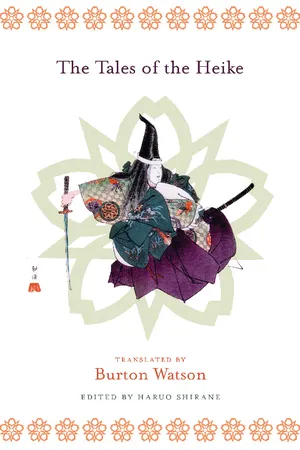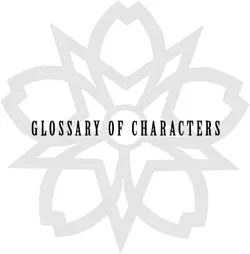![]()
The characters in The Tales of the Heike are usually listed under their personal (given) names, with cross-references provided where necessary. Emperors appear under their posthumous names used in the text (for example, Antoku). Abbreviated book and section references (for example, 1:1) in boldface type indicate the passages in which the historical figures appear in this translation, and those in lightface type signal events in other portions of the narrative. Variant texts of the Heike monogatari other than the Kakuichi version translated here and key episodes in later prose and dramatic genres are cited as well.
AKUGENDA: see Yoshihira.
AKUSHICHIBYŌE: see Kagekiyo.
ANTOKU, EMPEROR (1178–1185, r. 1180–1185): son of Emperor Takakura and Kenreimon’in (Tokuko). Taken by the Taira as they flee from the capital, he drowns at Dan-no-ura. He is also known as “the nation’s ruler,” “the late emperor,” “the emperor,” and “my son, the late emperor” [1:5, 7:16, 7:20, 11:9, Initiates 1, 2, 4, 5; 3:3, 4:1, 5:1, 7:9, 8:1, 8:3, 11:1].
ARIKUNI: Musashi no Saburōzaemon Arikuni, Taira samurai commander at the battle of Uji. He dies in the campaign against Yoshinaka [4:11; 7:4, 7:7].
ARIMORI (d. 1185): son of Taira no Shigemori. He takes his own life at Dan-no-ura [11:10; 6:10, 7:14, 7:19, 9:8, 10:1, 10:14].
ARIŌ: boy in Bishop Shunkan’s service. He travels to his master’s place of exile, witnessing his death. After cremating his master’s body, he takes religious orders [3:8, 3:9].
ASARI: see Yoichi (1).
ATSUMORI (1169–1184): son of Taira no Tsunemori and nephew of Kiyomori. He dies at the hands of Naozane at Ichi-no-tani. Atsumori’s death inspired many later works, including a work for the kōwaka-mai performance tradition, the nō plays Atsumori and Ikuta Atsumori, and Muromachi prose tales about the appearance of Atsumori’s ghost to his son (Ko Atsumori) [9:16; 7:19].
AWA-NO-NAISHI: daughter of Fujiwara no Shinsei (or, according to other texts, his granddaughter). One of Kenreimon’in’s companions in the Jakkō-in refuge, she is referred to as “an elderly nun” [Initiates 3–5].
BENKEI: Musashibō Benkei (d. 1189), warrior monk serving under Yoshitsune. Although Benkei has only a small role in the Kakuichi version, he plays an important part in the history of the Yoshitsune legend. Benkei is a central figure in The Tale of Yoshitsune (Gikeiki) and in shorter medieval prose tales like The Tale of Benkei (Benkei monogatari). He also appears in many nō and kabuki plays (Hashi Benkei, Funa Benkei, Ataka, and Kanjinchō) [9:9, 11:3, 11:7; 9:7, 12:4].
BEPPU NO KOTARŌ: young warrior in Yoshitsune’s entourage [9:9; 9:7].
CHANCELLOR: see Kiyomori.
CHIKAKIYO: Taira archer from Iyo Province at the battle of Dan-no-ura [11:8].
CHIKAKU: monk at Mount Kōya. He is consulted by Koremori when he takes holy orders [10:10].
CHIKAMASA: Fujiwara Chikamasa (1145–1210), sent by Regent Motomichi with a message for the Nara monks [5:14; 11:11].
CHIKANORI: [Kaneko no Yoichi] Chikanori of Musashi Province, serving under Yoshitsune [11:3; 9:7, 11:1].
CHIKAYOSHI: Saiin [no Jikan] Chikayoshi (1133–1208), official serving under Yoritomo [10:7; 8:5, 10:14].
CHŪJI OF SHINANO: [Kiso no] Chūji, serving under Yoshitsune [11:5].
COMMANDER: see Yoshitsune.
DAINAGON NO SUKE, LADY: daughter of Major Counselor Kunitsuna, wife of Taira no Shigehira, and wet nurse to Emperor Antoku. Captured at Dan-no-ura, she accompanies Kenreimon’in to the Jakkō-in refuge [Initiates 2, 3, 5; 10:2, 10:4, 10:6, 11:10, 11:11, 11:19].
EMPEROR: many of the references to “the emperor” or “the late emperor” are to Antoku. Other emperors and retired emperors mentioned by name are GoShirakawa, GoToba, Kanmu, Seiwa, Shōmu, Takakura, and Toba.
EMPRESS: see Kenreimon’in.
ENJITSU: Buddhist priest who buries Kiyomori’s remains [6:7].
FUHITO: Fujiwara no Fuhito (659–720), Lord Tankai, son of Kamatari. A leading political figure of his day, he was the founder of the Kōfuku-ji temple [5:14; 1:11, 7:9].
FUKAYABU: Kiyohara no Fukayabu, tenth-century courtier and poet [Initiates 3].
FUKAZU: Taira warrior at the battle of Uji [4:11].
GENTA: Tsuzuku no Genta, warrior on Prince Mochihito’s side at the battle of Uji [4:11; 4:10].
GENZŌ OF EDA: Eda no Genzō, warrior serving under Yoshitsune [11:3; 9:7, 11:7, 11:13, 12:4].
GINYO: younger sister of Giō. She is a shirabyōshi dancer [1:6].
GIŌ: daughter of Toji. She is a shirabyōshi dancer favored by Kiyomori [1:6].
GISHIN (also read YOSHICHIKA): leader of a rebellion in western Japan in 1100 [1:1; 5:5, 5:11, 6:6].
GOSHIRAKAWA, EMPEROR (1127–1192, r. 1155–1158): fourth son of Emperor Toba and retired emperor from 1169 until his death. His sons include Emperor Takakura and Prince Takakura (Mochihito), and Emperors Antoku and GoToba were his grandsons [1:6, 2:6, 2:7, 3:1, 5:19, 6:7, 7:16, 7:20, 10:5, 12:9, Initiates 3, 4; 1:5, 1:7, 1:9, 1:11–14, 2:1, 2:3, 2:10, 2:12, 2:16, 3:3, 3:15, 3:19, 4:1–4, 4:6, 4:8, 5:1, 5:10, 5:11, 6:1, 6:4, 6:5, 6:7, 6:10, 6:12, 7:13, 8:1, 8:2, 8:5, 8:10, 8:11, 9:1, 9:5, 9:17, 10:1, 10:13, 11:13, 12:1].
GOTOBA, EMPEROR (1180–1239, r. 1183/1185–1198): fourth son of Emperor Takakura and retired emperor until 1221, when he is exiled to the island of Oki. He is chosen to succeed his brother Antoku, whom the Taira have taken with them on their flight from the capital [12:9; 8:1, 8:10, 10:14; 11:13, 11:14].
HABUKU: warrior on Prince Mochihito’s side at the battle of Uji [4:11; 1:15, 4:10].
HARENOBU: doctor of divination [11:8].
HEYAKO NO SHIRŌ: Taira warrior at the battle of Uji [4:11].
HIDEKUNI: Kawachi no Hangan Hidekuni, Heike samurai commander [4:11; 7:2, 7:6].
HIDETŌ OF YAMAGA: Yamaga no Hyōdōji Hidetō, Heike commander of the vanguard boats at the battle of Dan-no-ura and the “finest archer in all of Kyushu” [11:7; 8:4].
HIGUCHI JIRŌ: see Kanemitsu.
HIROMI: Councillor Tachibana no Hiromi (837–890), author of the poem in Chinese (Wakan rōeishū, no. 693) recalled by Shigehira [10:7; 6:10].
HIROTSUNA (1): Genpachi Hirotsuna, Genji warrior serving under Yoshitsune [11:3, 11:7; 9:7, 11:11].
HIROTSUNA (2): Sanuki no Hirotsuna, Heike warrior at the battle of Uji [4:11; 9:7].
HOKKYŌ (DHARMA BRIDGE): Buddhist priest from Onaka in Kumano Province [9:15].
HŌNEN (1132–1212): “Priest Hōnen of Kurodani” on Mount Hiei, one of the founders of Pure Land Buddhism in Japan. He administers Buddhist precepts to Shigehira [10:5].
HOSSHŌ-JI ADMINISTRATOR: see Shunkan.
HOTOKE: shirabyōshi dancer from Kaga Province, whose name means “Buddha.” She is the subject of the nō play Hotoke no hara [1:6].
HŌZŌ: high-ranking tenth-century Tōdai-ji priest who was said to have visited hell (Genkyōshaku, book 4) [6:7].
ICHIRAI: warrior monk on Prince Mochihito’s side at the battle of Uji [4:11; 4:10].
ICHIJŌ OF KAI: see Tadayori.
IESADA: Sahyōe-no-jō Iesada, retainer of Taira no Tadamori [1:2].
IETADA OF MUSASHI: Kaneko no Jūrō Ietada, one of the “Kaneko brothers,” warriors serving under Yoshitsune [11:3; 9:7, 11:1].
IKE NUN: second wife of Taira no Tadamori, stepmother of Kiyomori, and mother of Yorimori. Her name (Ike no zenni) comes from the Ike home, Ike-dono (Pond Mansion), at Rokuhara. After the Heiji rebellion (1159), she asks that the thirteen-year-old Yoritomo be exiled rather than executed [5:10, 7:19, 10:13, 11:18].
IMAI: see Kanehira.
IMPERIAL CONSORT, IMPERIAL LADY: see Kenreimon’in.
INSEI: Reverend Insei (or, in some texts, Inzei), Chōraku-ji priest who administers Buddhist precepts to Kenreimon’in [Initiates 1].
ISHIDŌMARU: boy who accompanies Koremori, drowning with him [10:8, 10:9, 10:12].
JŪMYŌ MEISHŪ: warrior monk on Prince Mochihito’s side at the battle of Uji [4:11; 4:10, 4:16].
JŪRŌ OF MIONOYA: warrior serving under Yoshitsune [11:5].
KAGEIE (1): third son of Kajiwara Kagetoki and Genji warrior [11:3; 9:7, 9:11, 11:7].
KAGEIE (2): governor of Hida Province and Taira samurai commander [4:11; 2:3, 4:12, 7:9].
KAGEKIYO: Akushichibyōe Kagekiyo of Kazusa Province, Heike warrior. He continues to fight against the Genji after the battle of Dan-no-ura. Some variants of The Tales of the Heike describe how he is captured as he tries to assassinate Yoritomo at Nara. He also is the subject of nō drama (Kagekiyo) and other genres [4:11, 11:5, 11:7; 7:2, 8:9, 9:10, 10:14, 11:11, 12:9].
KAGESUE: eldest son of Kajiwara Kagetoki and Genji warrior [9:15, 11:7; 9:1–3, 9:7, 9:11].
KAGETAKA (1): second son of Kajiwara Kagetoki and Genji warrior [11:3; 9:7, 9:11].
KAGETAKA (2): son of Kageie, the governor of Hida Province, and Taira warrior. He dies in the northern campaign against Yoshinaka [4:11; 7:2, 7:6...

